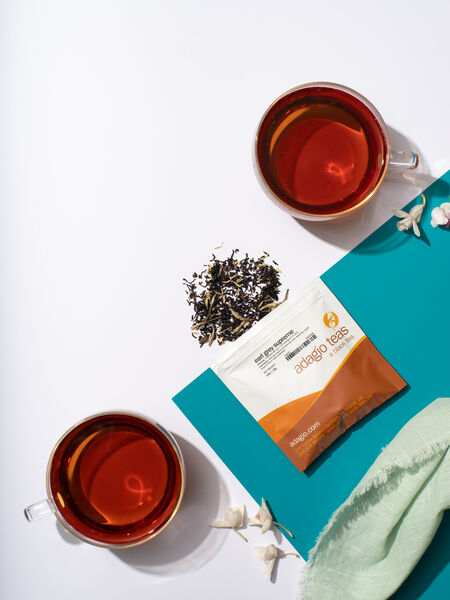Earl Grey Supreme: Bergamot at Its Finest

A Tea Blend Classic Adds Elegance to Afternoon Tea
Whether new or a veteran of British-style afternoon tea, the question remains, “What tea to serve?”
For nearly two centuries, the choice for millions has been Earl Grey, a distinctly intriguing black tea made with the essential oil from the rind of the Italian citrus fruit, bergamot.
Artisanal blenders have gone beyond the classic recipe to make the eponymously-named Earl Grey Supreme, a drink as elegant and as delicious as anyone has ever served. Our exceptional new blend includes both the classic Keemun for a rich softness and a full-bodied Ceylon for body which allow the sparkling bergamot’s aroma to titillate palate and nose.
Going a step further, we’ve added both a sprinkle of Silver Needle white tea buds for complexity and white cornflowers for a rumor of floral delicacy, best brewed for 3-5 minutes with boiled, filtered or spring water.
Earl Grey Supreme, artisanal tea blend at its finest.
MYTHS POSING AS HISTORY
Two British tea blenders lay claim to the blend. The first, Jacksons of Piccadilly, avers the blend was given to them in the mid 19th century by the 2nd Earl Grey (Charles, 1765-1845.) The second myth is that, in that same era, Twinings allegedly offered “bespoke blends” tailored to esteemed customers, one of which they named Earl Grey for Charles.
Legions of the blend’s fans cling to these myths, and one more, now totally debunked, that this blend was created by a mandarin grateful for the service of the Earl. Alas, Charles never ventured to China although the politics of the tea trade was infinitely changed he became Prime Minister. In 1833 his administration busted The East India Company (1600-1874) for its monopoly on China tea trade, opening it up for free trade with Europe.
This greatly increased profits for China, so it’s not too difficult to imagine that some still-nameless mandarin, and thousands of Chinese tea sellers, were grateful to the PM for his policy change. Still, the blend would most certainly have not been made with a black tea (Chinese drank primarily greens and exported black teas) and not flavored with bergamot, which did not grow there, although small amounts do now.
GOOD TEA RELIES UPON GOOD WATER
The truth about the origin of the blend may well be based on an essential to an excellent cup of tea: water quality.
Living in Northumberland, Charles (aka Viscount Howick) was keenly aware that the water quality was subpar with extensive lime scale (minerals) which made the water very alkaline at Howick Hall, the family home since 1316. Teas were quite expensive, and he dearly loved them, especially the more expensive black tea selections like Fo Shou and Qimen (Keemun.) Finding a way to enjoy these teas without the alkaline edge of local water must have been a dedicated goal.
WHY BERGAMOT?
Because bergamot is acidic and can neutralize the water, it may be that the Earl (or a chef or local tea blender) suggested that bergamot oil be added to teas to mask the lime in the water. (Yes, there was a time before the GraviTea water filter!)
The Italian citrus fruit, Citrus bergamia, aka the bergamot orange, is pear-shaped, the size of an orange, and yellow or green, depending on ripeness. The fruit itself it is too bitter to eat but the oil in its rind has a delicate fragrance that is citrusy, musky, and floral which made it popular throughout Europe for soaps and perfumes.
When candied, the rind can be eaten in marmalades, preserves, and … tea. The etymology of bergamot may be the Turkish word beg-armudi, meaning “prince’s pear”(Turkey grows modest amounts); or it may refer to Bergamo, a city in Italy, which grows 80% of the world’s supply.)
Charles, the 2nd Earl Grey, painted by Thomas Phillips, circa 1820.
HOW DID THE GREYS BECOME EARLS?
The Court bestowed a hereditary title upon the Grey family in 1806 and, certainly, Charles repaid the honorific by serving his country admirably. As Prime Minister (1830-34,) he directed the abolition of slavery across the British Empire via the Slavery Abolition Act of 1833, (although he allowed former slave owners compensation), and is credited with the Great Reform Act (1832) which updated the electoral system to allow more than 18% more people the right to vote, but not yet women or the working class.
Charles had 16 legitimate children, so yes, the lineage continues with Peter Kent Grey (1940) who is a British naval pilot and the hereditary peer as the 7th Earl Grey. We believe he’d love our homage to his valiant and accomplished ancestor.
Earl Grey Supreme, with its unique, and delicious, touch of white cornflowers and Silver Needle tea buds, is as elegant and as satisfying an Earl Grey tea as ever graced a royal’s tea table, or yours!
